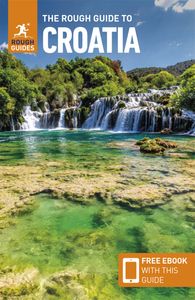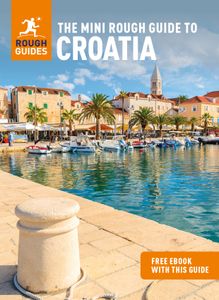Bačvice
The main visitor-magnet east of the city centre is Bačvice beach, a few minutes’ walk east of the ferry terminal. A popular destination for Splićani of all ages, Bačvice is the spiritual home of picigin, a game only played in and around Split, which works rather like a netless version of volleyball in the sea, involving a lot of acrobatic leaping around as players try to prevent a small ball from hitting the water. Immediately behind the beach is a chic modern three-tier pavilion, resembling a cross between an Art Deco seaside building and a high-tech metal tent. With several cafés and a couple of swanky eating places inside, it’s a popular venue for after-dark drinking and feasting throughout the year. A coastal path leads east from Bačvice past a couple of smaller bays, passing the tennis club where 2001 Wimbledon champion Goran Ivanišević honed his skills. There are plenty more cafés along the way, and the whole stretch is a popular strolling area all year round.
Beaches in Split
For a major city Split has quite a variety of beaches offering clean, safe swimming, all within easy reach of the centre. These are just three of the best.
Bačvice
Bačvice is the most popular of Split’s beaches, largely thanks to its central location but also because of its uniquely shallow, sandy floor. Bathers can safely wade out for quite a distance, which makes it popular with paddling families. There is a well-equipped children’s playpark in the square immediately behind the beach, and the cafés and restaurants of the Bačvice pavilion are nearby.
Žnjan
Four kilometres east of the centre (reached from Bačvice via coastal footpath; otherwise catch bus #8 from outside the central market), Žnjan is a part-pebble, part-gravel beach that was laid out relatively recently – this part of Split’s shoreline was where Pope John Paul II held Mass in front of 50,000 people in October 1998. The beach area is still a bit gravelly and rough underfoot, but there is a wealth of facilities including cafés, a playpark, bouncy castles and a karting track.
Kašjuni
Four kilometres west of town, on the south side of the Marjan peninsula, Kašjuni is a strip of fine shingle that largely lacks any accompanying facilities, thereby making it the perfect choice for connoisseurs of idyllic bays. Reached by an unmarked side road about 1km beyond the Ivan Meštrović Museum, it faces out towards the green island of Čiovo and feels totally removed from the bustle of the city.
Around Split
Salona
Five kilometres inland from Split, at the foot of the mountains that divide the coastal plain from the Zagora, is the sprawling dormitory suburb of Solin, a characterless modern town which has grown up beside the ruins of Salona, erstwhile capital of Roman Dalmatia and probable birthplace of Diocletian. The town once boasted a population of around sixty thousand and was an important centre of Christianity long before Constantine legalized the religion throughout the empire – prominent leaders of the faith (future saints Domnius and Anastasius among them) were famously put to death here by Diocletian in 304. It was later the seat of a powerful Byzantine bishopric until 614, when the town was comprehensively sacked by a combined force of Slavs and Avars, and the local population moved off to settle in what would subsequently become Split.
Klis
The town of Klis grew up around a strategic mountain pass linking the coast with the hinterland of the Zagora. The steep rock pinnacle around which the modern town huddles was first fortified by the Romans before being taken over by the expanding medieval kingdom of the Croats; kings Mislav (835–45) and Trpimir (845–64) both based their courts here. Klis remained in Hungaro-Croatian hands until the sixteenth century, when the Turks, already in command of Bosnia, began pushing towards the coast. Commanded by Captain Petar Kružić, Klis withstood sieges in 1526 and 1536, but finally succumbed to Ottoman attack in 1537, when attempts to relieve the citadel ended in failure. Kružić himself was captured and executed; the sight of his head on a stick was too much for Klis’s remaining defenders, who gave up the fortress in return for safe passage north. The use of Klis Fortress in fantasy series Game of Thrones (in which it doubled as Meereen, the slaver-city conquered by a certain Daenerys Targaryen, if you must know) has provided the site with an additional layer of mystique.
The present-day town straggles up the hillside beneath the fortress and is divided into three parts: Klis-Varoš, on the main road below the fortress; Klis-Grlo, at the top of the hill where the Drniš and Sinj roads part company; and Klis-Megdan, off to one side, where you’ll find the main gate to the site.
The fortress
The fortress (tvrđava) is a remarkably complete structure, with three long, rectangular defensive lines surrounding a central strongpoint, the Položaj maggiore (Grand Position, a mixed Croatian–Italian term dating from the time when Leonardo Foscolo captured the fortress for the Venetians in 1648), at its eastern end. There’s no real museum display and very little labelling, but the fortress interior is immediately impressive, with cobbled walkways zigzagging their way up through a succession of towered gateways. You can peek inside several dusty storehouses, barrack blocks and – near the fortress’s highest point – an ancient stone chapel that briefly served as a mosque during the Ottoman occupation. The views from the walls are truly breathtaking, with the marching tower blocks and busy arterial roads of suburban Split sprawling across the plain below, and the islands of Šolta and Brač in the distance.
Split festivals
Feast of St Domnius
(Sveti Dujam or, more colloquially, Sveti Duje) May 7. The city’s protector is celebrated with processions, Masses and general festivity. Domnius is also the patron saint of woodwork, and you’ll see craftsmen selling chairs, tables, barrels and carvings in Split market on the days surrounding the feast.
Mediterranean Film Festival
(Festival mediteranskih filmova) Early June. Features and documentaries with a strong regional focus, with showings at open-air cinema Bačvice and Kinoteka Zlatna Vrata, and DJ-led after-parties.
Ultra Europe
Early July. Sixty thousand revellers descend on Poljud stadium for a long weekend, celebrating the best in electronic dance music with live acts and DJs until the early hours. With the city filling up with festival-goers, accommodation prices go through the roof. Website.
Split Summer Festival
(Splitsko ljeto) Mid-July to mid-August. In the summer Split hosts a spate of cultural events – including top-quality theatre, a lot of classical music and at least one opera – many performances of which take place on outdoor stages in the Peristyle and other Old Town squares. Tickets are available from the HNK box office.
Split Film Festival
September. Independent, radical and subversive features, shorts and documentaries. The main venues are Kino Karaman and Kino Zlatna Vrata. Website.
Top image: Split,Croatia. © novak.elcic/Shutterstock























